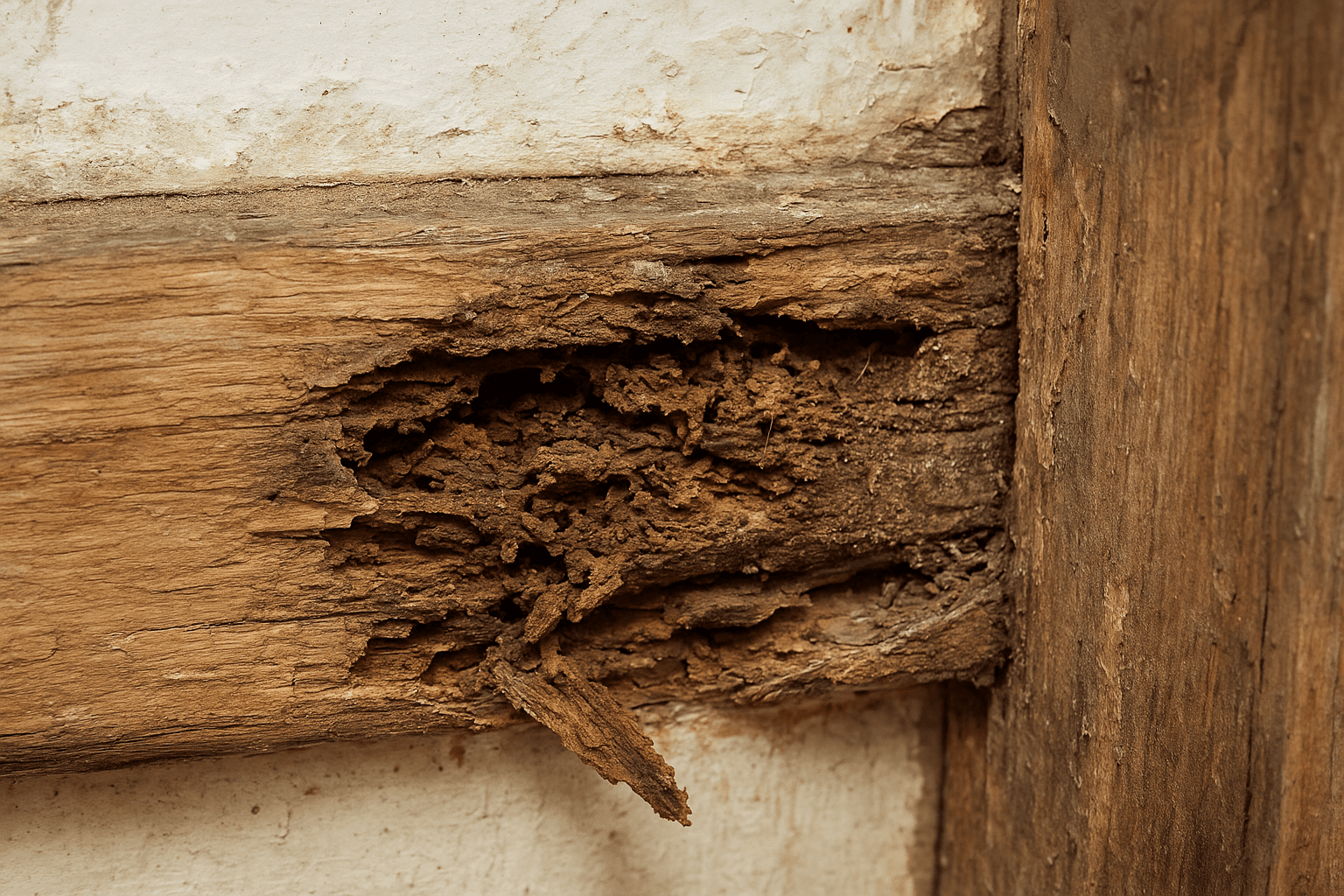Will Wet Rot Stop Your House Selling?

Estimated reading time 7 minutes
When selling a home, the presence of wet rot can be a significant concern for both homeowners and potential buyers. Wet rot is a type of timber decay caused by fungal growth in persistently damp wood. Unlike dry rot, wet rot remains localised to the area affected by moisture and does not spread aggressively through masonry or other structural elements. However, its impact on property value and saleability can still be substantial. Understanding what wet rot is, how to spot it, and how to treat it is essential if you want to sell your house smoothly.
What is wet rot?
Wet rot refers to a group of fungi that thrive in timber with a consistently high moisture content. The most common species causing wet rot is Coniophora puteana, sometimes known as the cellar fungus. These fungi break down the structure of the wood, weakening it over time and potentially leading to structural damage if left untreated.
Wet rot commonly affects areas of the home exposed to water or damp conditions, such as roofs, window frames, skirting boards, floor joists, and even timber inside walls. Unlike dry rot, which can spread across walls and floors, wet rot usually stays confined to the damp timber where it started.
Although wet rot can appear in any wooden structure, properties with older timber or insufficient ventilation are particularly at risk. Homes with leaks, poorly maintained gutters, or high humidity areas are common breeding grounds.
Early signs of wet rot
Spotting wet rot early can save both time and money. The following signs may indicate that wet rot is present in your property:
- Damp, musty smell: Often one of the first indicators, a persistent musty odour can point to fungal growth inside walls or under floorboards.
- Discoloration or dark staining: Affected timber may show dark brown or black stains along the grain.
- Cracking or splitting along the grain: As the wood weakens, cracks or splits often appear.
- Soft, spongy texture: Timber affected by wet rot feels soft and may even crumble when pressed.
- Visible fungal growth: In severe cases, white, grey, or brown fungal strands may appear on the surface of the wood.
Early detection is crucial because minor wet rot can often be treated quickly, whereas advanced damage may require extensive repairs or replacement of structural timber.
What’s the difference between wet rot and dry rot?
It’s easy to confuse wet rot and dry rot, but the two have important differences that affect treatment and home sale considerations:
- Wet rot: Requires high moisture content (generally above 50%) to thrive. It remains localised, usually limited to the timber directly exposed to dampness. Wet rot rarely spreads beyond its immediate source.
- Dry rot: Can grow at lower moisture levels (around 20–30%) and spreads aggressively through timber and even masonry. Dry rot can travel across walls, floors, and ceilings, potentially affecting the structural integrity of an entire property.
Both types of rot weaken timber, but dry rot is generally considered more dangerous and expensive to treat. When selling your home, a mortgage lender or buyer may be more cautious about properties with dry rot, although wet rot can still reduce market appeal.
What causes wet rot?
The primary cause of wet rot is prolonged exposure to moisture. Without addressing the source of dampness, treatment will only be a temporary solution. Common causes include:
- Leaking roofs or gutters: Water penetrating the roof can seep into joists and beams, providing the damp conditions that wet rot needs to grow.
- Poor ventilation: Attics, basements, and cupboards with little airflow create humid environments where timber is more susceptible to fungal growth.
- Rising damp: Moisture from the ground can travel up walls, affecting skirting boards and timber floorboards.
- Condensation: Poorly insulated walls and windows can lead to condensation forming on surfaces, which can eventually trigger wet rot in nearby wood.
Preventing wet rot requires not only treating the affected timber but also eliminating these underlying causes of moisture.
Wet rot treatment and repair costs
Treating wet rot typically involves two steps: removing the affected timber and addressing the source of moisture. In some cases, chemical treatments can be applied to kill the fungus and prevent recurrence.
Costs can vary widely depending on the severity of the damage and the area affected:
- Minor repairs, such as treating small sections of timber and improving ventilation, can cost around £500–£1,000.
- Moderate repairs involving replacement of floorboards, window frames, or small beams can cost between £1,000–£2,500.
- Extensive repairs to structural timber may exceed £3,000, particularly if multiple areas of a property are affected.
Professional treatment ensures that the rot is fully removed and that the repaired timber is protected from future fungal growth. Attempting DIY fixes can be risky, as incomplete treatment may allow wet rot to return.
Is wet rot dangerous to health?
While wet rot itself is not directly harmful to human health, the damp conditions that allow it to thrive can create a suitable environment for mould and mildew. Exposure to mould spores can lead to respiratory issues, allergic reactions, or aggravate asthma, particularly in children, the elderly, or those with pre-existing conditions.
For this reason, addressing wet rot is important not only to protect the property but also to ensure a safe living environment for occupants or potential buyers.
Will wet rot affect your home sale?
Yes, wet rot can impact your ability to sell your home. Potential buyers are often wary of properties with timber decay, both because of the cost of repairs and the potential for ongoing damp problems.
Additionally, mortgage lenders may hesitate to finance properties with structural timber affected by wet rot, which can limit the pool of interested buyers. Even if buyers are willing to consider the property, they may use the presence of wet rot to negotiate a lower sale price.
Selling a property with wet rot
If your property has wet rot, there are several ways to proceed:
- Repair the damage: Addressing wet rot before listing can make your home more attractive to buyers and may result in a higher sale price. This approach is recommended if the rot is moderate or if you have time to invest in repairs.
- Sell as-is: Some buyers specialise in purchasing properties with issues like wet rot. While the sale price may be lower, it can be a faster option and avoids the stress of organising repairs yourself.
- Sell to a cash buyer: Companies like Bettermove offer quick cash offers for homes, even those with structural issues such as wet rot. This approach is particularly useful if you need a fast sale and want to avoid costly repair delays.
Choosing the right approach depends on the severity of the rot, your timeline for selling, and how much you are willing to invest in repairs.
Wet rot doesn’t mean you can’t sell your property
Wet rot can be a significant concern for homeowners looking to sell, but it does not have to prevent a sale entirely. By understanding what wet rot is, spotting early signs, addressing the root causes, and exploring repair or sale options, you can manage the situation effectively.
Whether you choose to repair the timber, sell the property as-is, or use a cash house buyer service like Bettermove, acting promptly will minimise damage, protect the value of your home, and make the sale process smoother for all parties involved.
For more information on selling properties with structural issues or exploring quick-sale options, visit Bettermove.

